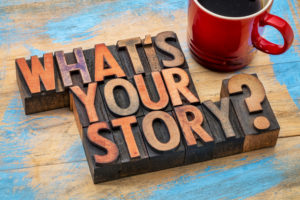
Have you ever wondered where good storytellers get their stories? I did, and I wanted to learn how to find my own stories worth sharing. Several years ago I was working on my first keynote speech and knew I could use some guidance. I hired Judy Carter, an international motivational speaker, author of Message of You, former stand-up comedian and coach. When we began what turned out to be an eight month process, she told me “you first need to find the mess before you can create the message.”
One of the exercises in The Message of You was to identify a day that started off bad but ended up better than expected. Your stories don’t have to be large and filled with drama to be effective. My task was to create a list of “bad day – good day” events, and I was surprised that it turned out to be a rather long list. It is amazing how many memories come flooding back when doing this exercise. Some memories were huge and dramatic – we all have defining moments we can recall. My big stories include being adopted, going through a divorce and having arterial septal defect surgery. While all were both huge and dramatic, they weren’t the stories I wanted to tell.
What I learned was to look for other incidents that had the potential to be really bad, but ended well. When you identify that bad day moment, work backward to the beginning when everything was just fine. That is your starting point in finding your story.
Here is an example of one of my messes:
It was January 3, 2014, and my son and I had traveled from Columbus, Ohio to Miami to watch the Orange Bowl. Our Ohio State Buckeyes ended up losing to Clemson but that didn’t upset me. The trip was all about spending time with my son.
After the game we headed back to the rental car and my heart sank when I realized I had left the lights on; the battery was totally dead. I did begin to panic a bit as we waded through the crowd looking for someone to help us. Then a very nice Clemson fan offered to jump our car. I tried to pay him, but he said: “pay it forward.” Okay, OSU lost and our car had to be jumped, but not such a bad day, right?
With the car started, we drove away. That’s when I realized that I left my diabetes kit that contained my insulin, meter, and test strips in the stadium. I had no backup supplies. That’s when I really began to panic. I tried to calmly share my diabetes dilemma with my son, but I knew he could see the fear on my face. He calmly said, “Dad, there has to be a Walgreen’s close by where you could get your insulin and supplies you need.”
He was right, there was a 24-hour Walgreen’s close to our hotel. When I told the pharmacist my situation, he said he would try to help me out. Of course, there were the usual issues with finding the correct prescription and insurance but the pharmacist got me all set up. Long story short, and several messes later, I walked out with all the supplies I would need to make it back home and $550 lighter in my wallet.
The first step to defining your story is to find those messes and put them down on paper. If you struggle with this, refer to an earlier blog posting, “The Five Components for a Solid Foundation to a Good Story,” where I discuss that every good story has a hero and a villain. In other words, there is a problem (villain) that needs a solution (hero) to overcome the problem at hand. I have found when I encourage people to think about their stories in this way, a big light bulb goes on. Every day each of deal with problems, obstacles, issues. Think about that, and a floodgate of ideas will open up.
Take time to create a list of problems that you, the hero, have solved. You will be astounded at the number of potential stories you have at your fingertips. My next blog post will focus on techniques to craft your story into something memorable. Remember, small messes can make huge and dramatic stories!
